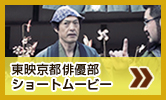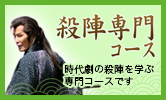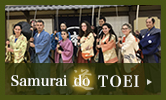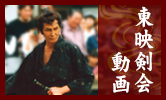
Studio Overview
UZUMASA, a neighborhood in Kyoto, is a mecca of the Japanese motion picture industry. The first motion picture facility in this area was built 300m west of Keifuku Uzumasa station in a neglected bamboo forest in Hachigaoka by Bando Tsumasaburo in 1926, when Keifuku railway was opened between Kitano and Katabira-no-Tsuji. The original studio was called Bantsuma Productions. The studio was renamed several times until the end of the WWII, when it became Toei Studios Kyoto.
Towards the end of the WWII, the studio was forced into dormancy due to government wartime restrictions. In 1947, Mitsuo Makino resumed feature film production on the lot as the Toyoko Motion Picture company. Toyoko increased their number of motion picture productions and made some unforgettable films, including "Kike Wadatsumi No Koe: Nippon Senbotsu Gakusei Shuki" (1950)."
In 1951, Toyoko Eiga, Oizumi Eiga and Tokyo Eiga Haikyu were consolidated under Toei Company Limited; Toyoko Eiga Studios was renamed Toei Studios Kyoto. Soon, Toei rose to the top of domestic box office sales. Toei Kyoto's samurai fiction became popular with everyone from children to senior citizens. Toei Kyoto films were known as popular entertainment and they included many masterpieces: "Miyamoto Musashi" (1961), "Bushido" (1963), and "Battles Without Honor and Humanity" (1973). However, the Japanese film industry began a general decline around 1960, and Toei Studios Kyoto was no exception. The number of samurai film productions decreased and the company started concentrating on epic films such as "Hangyakuji", focusing more on quality than quantity. Notably, "Bushido Zankoku Monogatari" won the Golden Bear at the 1963 Berlin International Film Festival.
During this period, historical dramas started to move from theaters to television, so the Toei Kyoto TV Production and Toei Kyoto Production companies, which had begun focusing on producing TV programs, were established within the parent studios. They made a lot of popular TV historical drama series, including "Shinobi no Mono", "Suronin, Tsukikage Hyogo", "Zenigata Heiji", "Akakage", "Toyama no Kin-san", "Moeyo Ken", and others. Although less prolific than in years past, Toei Studios Kyoto has recently produced a wide variety of films, including "Sennen no Koi - Hikaru Genji Monogatari", a 10th century royal dynasty story; "Cha-cha", a story set in the age of provincial wars; "Tsukigami", an Edo period story; and "Otoko-tachi no Yamato", a WWII story.
In 2011, Toei turns 60 and Toei Studios turns 85. We hope you enjoy our filmmaking and hospitalities in the spirit of samurai fiction.
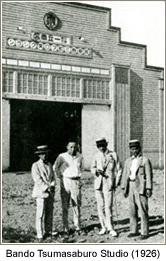
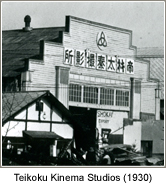
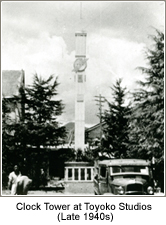
Photos courtesy of Movie Culture Hall Archives, Toei Studios Kyoto.


